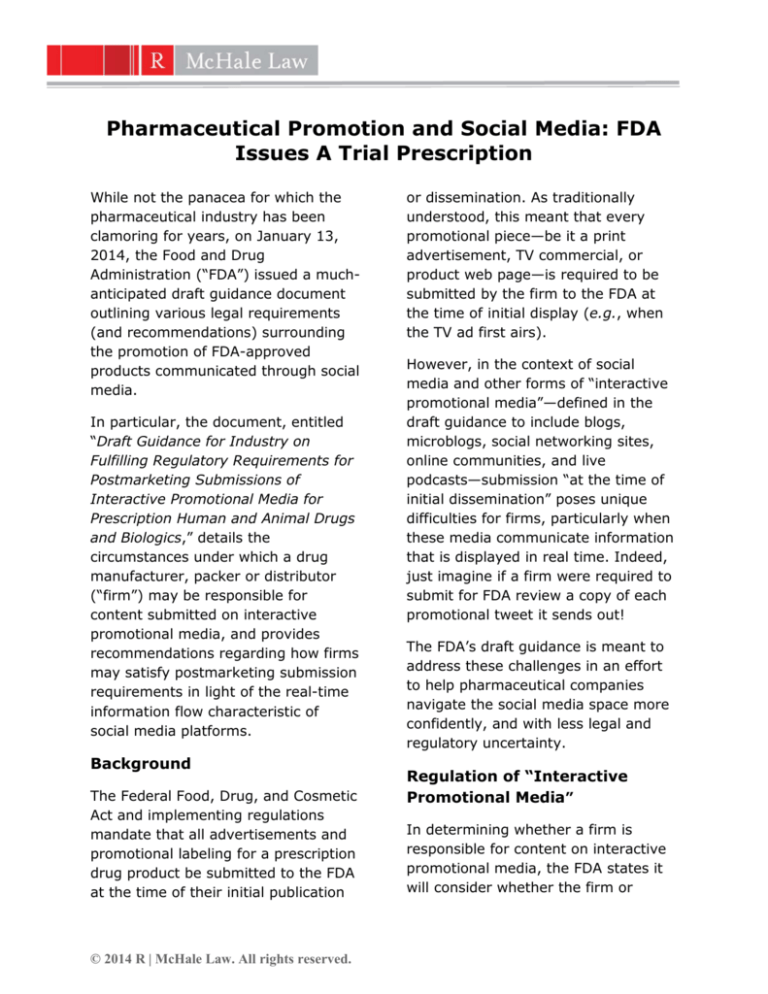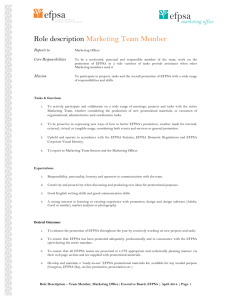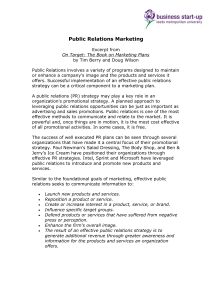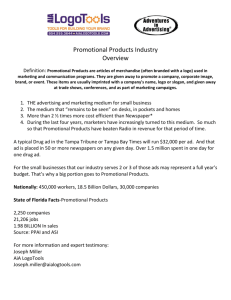
Pharmaceutical Promotion and Social Media: FDA
Issues A Trial Prescription
While not the panacea for which the
pharmaceutical industry has been
clamoring for years, on January 13,
2014, the Food and Drug
Administration (“FDA”) issued a muchanticipated draft guidance document
outlining various legal requirements
(and recommendations) surrounding
the promotion of FDA-approved
products communicated through social
media.
In particular, the document, entitled
“Draft Guidance for Industry on
Fulfilling Regulatory Requirements for
Postmarketing Submissions of
Interactive Promotional Media for
Prescription Human and Animal Drugs
and Biologics,” details the
circumstances under which a drug
manufacturer, packer or distributor
(“firm”) may be responsible for
content submitted on interactive
promotional media, and provides
recommendations regarding how firms
may satisfy postmarketing submission
requirements in light of the real-time
information flow characteristic of
social media platforms.
Background
The Federal Food, Drug, and Cosmetic
Act and implementing regulations
mandate that all advertisements and
promotional labeling for a prescription
drug product be submitted to the FDA
at the time of their initial publication
© 2014 R | McHale Law. All rights reserved.
or dissemination. As traditionally
understood, this meant that every
promotional piece—be it a print
advertisement, TV commercial, or
product web page—is required to be
submitted by the firm to the FDA at
the time of initial display (e.g., when
the TV ad first airs).
However, in the context of social
media and other forms of “interactive
promotional media”—defined in the
draft guidance to include blogs,
microblogs, social networking sites,
online communities, and live
podcasts—submission “at the time of
initial dissemination” poses unique
difficulties for firms, particularly when
these media communicate information
that is displayed in real time. Indeed,
just imagine if a firm were required to
submit for FDA review a copy of each
promotional tweet it sends out!
The FDA’s draft guidance is meant to
address these challenges in an effort
to help pharmaceutical companies
navigate the social media space more
confidently, and with less legal and
regulatory uncertainty.
Regulation of “Interactive
Promotional Media”
In determining whether a firm is
responsible for content on interactive
promotional media, the FDA states it
will consider whether the firm or
anyone acting on its behalf is
influencing or controlling the
communication, either in whole or in
part.
educational grant), with no additional
control or influence over the thirdparty site, then the firm would not be
responsible for the site’s content.
In particular, the draft guidance
specifies that a firm is accountable for
promotional activities in the following
circumstances:
Promotional Content Created by An
Agent or Employee of the Firm. The
draft guidance notes that the “FDA’s
regulation of prescription drug product
promotion extends both to
promotional activities carried out by
the firm itself, and to promotion
conducted on the firm’s behalf.” For
example, firms have responsibility for
the content of the social media posts
created by an employee or agent
acting on the firm’s behalf—such as
bloggers, sales representative or paid
professional speakers—, and are
subject to the FDA’s postmarketing
submission requirements in these
circumstances.
Promotional Content on Sites Owned,
Controlled, Created, Influenced or
Operated by, or on Behalf of the
Firm. The draft guidance provides that
a manufacturer “is responsible for
product promotional communications
on sites that are owned, controlled,
created, influenced, or operated by, or
on behalf of, the firm.” This category
includes not only company-sponsored
websites, blogs, discussion boards,
chat rooms, and the like, but also
pages created, maintained, or
otherwise influenced by the company
on other interactive platforms, such as
a company’s Facebook page.
Promotional Content on Third-Party
Sites. The draft guidance provides that
a firm is responsible for product
promotion on a third-party site if it
has any control or influence on the
third-party site, even if that influence
is limited in scope. For example,
collaboration on, or editorial, preview
or review privileges associated with
content on a third-party site—such as
influencing the placement of the firm’s
promotional message—would be
sufficient to trigger postmarketing
submission requirements. However, if
a firm only provides financial support
(e.g., through an unrestricted
Representing perhaps the most
notable (and welcome) statement of
the FDA’s “current thinking” regarding
social media, as it relates to usergenerated content (“UGC”), including
“comments,” “shares,” and “likes,”
that is posted on the firm’s own
Facebook page, blog, or forum, the
draft guidance clarifies that a firm is
“generally” NOT responsible for such
content “that is truly independent of
the firm (i.e., is not produced by, or
on behalf of, or prompted by the firm
in any particular).” Further, the “FDA
will not ordinarily view UGC on firmowned or firm-controlled venues such
as blogs, message boards, and chat
rooms as promotional content on
behalf of the firm as long as the user
rmchale.com
2
has no affiliation with the firm and the
firm had no influence on the UGC.” To
that end, the FDA recommends that a
firm be transparent in disclosing its
involvement on a site by clearly
identifying any communications of its
employees or third parties acting on
behalf of the firm.
Recommendations for
Postmarketing Submissions
The draft guidance also provides
detailed recommendations on how
firms can fulfill regulatory
requirements for postmarketing
submissions relating to branded,
promotional content on social media.
Recommendations of special note
include:
1. For all sites for which it is
responsible, a firm should
submit in its entirety all such
sites on Form FDA 2253
(Transmittal of Advertisements
and Promotional Labeling for
Drugs for Human Use) or Form
FDA 2301 (Transmittal of
Periodic Reports and
Promotional Material for New
Animal Drugs) at the time of
initial dissemination, including
the static product website with
the addition of interactive or
real-time components (e.g.,
comments sections, live chat,
etc.).
2. For third-party sites on which a
firm’s participation is limited to
interactive or real-time
communications, a firm should
rmchale.com
provide the home page of the
third-party site, along with the
interactive page within the
third-party site and the firm’s
first communication on Form
FDA 2253 (or 2301, as
applicable) at the time of initial
display.
3. For restricted (i.e., passwordprotected or subscriptionbased) sites, once every month
firms should submit on Form
FDA 2253 (or 2301, as
applicable) all content related to
the discussions, including all
UGC about the topic regardless
of whether the UGC is
independent or not, together
with screenshots or other visual
representations of the actual
site, including the interactive or
real time communications.
Formatting factors (such as
appearance, layout, and visual
impression) should also be
taken into consideration when
submitting communications to
the FDA to enable the FDA to
view the communications as a
whole.
4. For non-restricted sites for
which it is responsible or in
which it remains an active
participant and that include
interactive or real-time
communications, firms should
submit a completed Form FDA
2253 (or 2301, as applicable)
once every month, together
with an updated listing of all
3
such sites, which includes the
site name, URL, and date
range, as well as a crossreference to the date of the
most recent site submission.
Screen shots or other visual
representations of the
interactive or real-time
communications are NOT
required for publicly accessible
sites.
Looking Ahead
The draft guidance represents only a
small (albeit, significant) step forward
towards achieving a more
comprehensive statement of the social
media regulatory guidelines the FDA
has been promising pharmaceutical
companies for years.
While the draft guidance may help
allay some concerns of pharmaceutical
companies leery of engaging in social
media, many questions (and therefore
uncertainties) remain, including issues
arising out of character space
limitations (as it relates to risk-related
and warning information), adverse
event reporting, and the obligation, if
any, to correct false, misleading, or
off-label information about a firm’s
product posted on third-party
websites.
guidance until April 14, 2014. Industry
stakeholders should be sure to weigh
in and join the conversation.
A copy of the draft guidance can be
found here.
If you have any questions about this
article, please contact:
Robert McHale, Esq.
R | McHale Law
9 West Broadway, Suite 422
Boston, MA 02127
Tel. 617.306.2183
Email: robert.mchale@rmchale.com
DISCLAIMER: The contents of this publication
are not intended, and cannot be considered, as
legal advice or opinion. The contents are
intended for general informational purposes
only, and you are urged to consult an attorney
concerning your situation and any specific legal
questions you may have.
Fortunately, the FDA is expected to
release additional guidance documents
addressing these and other related
issues in the upcoming months.
In the meantime, the FDA will be
accepting comments on the draft
rmchale.com
4










